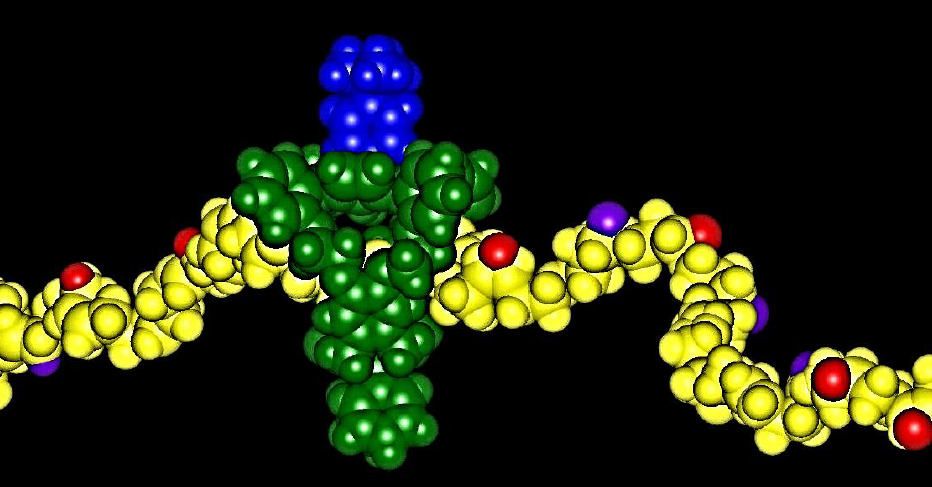
Data storage has been around for ages. In the beginning, for example, there were hieroglyphics, marks on stone and walls. Now it seems possible to use a car tire to process a huge amount of data as a solution for the tidal wave of data that has now become almost impossible to process. Radboud University is trying to make a contribution to a near future in which this will be possible.
The activities of the researchers in Nijmegen, Netherlands, are part of a long tradition. This was made clear in a Zoom interview by researchers involved, Dr Hans Elemans (senior lecturer) and Prof. Roeland Nolte (professor emeritus).
“We are a small research group, working in the supramolecular field,” explains Elemans. This is officially called molecular nanotechnology. “In 1987, the Nobel Prize was awarded in that field. And again in 2016, this time for the Dutchman Feringa. The latter has become known as the inventor of the so-called molecular motor, which is being used in Nijmegen to attempt to initiate a new method for storing data. The molecular device contains a minuscule motor, 80,000 times smaller than a hair, which can be controlled by light.
Data storage solution
Finding a solution to the data tsunami is a search for the holy grail, to which the allegedly small research group wants to give a boost. Capacity, cost, shelf life and energy set limits to what is now possible for data storage.
Elemans comments on the necessity: “Bear in mind that in 2005 you still needed 0.12 zettabyte (1 ZB = 1021 byte, ed.) of data storage and that it has now become 44 zettabyte. That will be 2,000 in 2040, if you extrapolate. It may seem like we are entitled to it, but data storage costs a lot. It requires a great deal of capacity in and around data centers, as well as more and more energy. Moreover, the required amount of silicon for the creation of hard disks is running out for those data centers.”
The Nijmegen scientist gives a few illustrations of what the expanding data means. “In 2015 there were 416 terrawatt hours of energy needed for storage. That is more than the United Kingdom consumed in that year, namely three hundred terrawatt hours. Or take Googling three hundred times. That’s equivalent to boiling one liter of water.”
Synthetic polymers from tires
It should be more efficient. The core of Nijmegen’s efforts is to enable storage at the molecular level, specifically in the form of data on molecular chains. Synthetic polymers in the form of long wires are used for this purpose. “These are basically very stable. You could compare it to books or CDs that have a limited shelf life and capacity. For example, books last five hundred years at most and DVDs or CDs last fifty years. The storage potential of polymers is much greater, with a shelf life of up to five thousand years.”

With that knowledge, the example of the car tire becomes relevant. Elemans believes that all the data in the world could be captured on a single car tire using this technology. It is for this reason that polybutadiene, a cheap main component of a car tire, is being experimented with.
He then explains what they and a recent publication in Nature Communications were talking about. “The problem so far is the writing time. The faster that can be done, that’s where we come into the picture.”
The ‘trick’ is to be able to write zeroes and ones using light at a micro-level. For a layman it looks a bit like being busy with needle and thread. Scientists have already achieved the storage of information on DNA chains (natural polymers) and in the case of artificial polymers the first steps are being taken. To do this, the molecular read/write head of the already mentioned molecular device moves along the long molecular chain (polymer) and captures oxygen atoms in the form of left or right oriented epoxide bonds. It can be compared to writing zeroes or ones on the molecular chain, in the same way as it is done on a hard disk. The technique works and it’s fast.
Controlling the writing process with light
Polybutadiene is suitable for testing because it has simple polymer chains containing double bonds. These bonds can be converted with a catalyst into epoxides that can go in two directions, comparable to a zero or a one.
The problem with that writing process was the lack of control over what became a ‘zero’ and what became a ‘one’. After some tinkering, it seems that this can be controlled by light. A next step is the actual writing of zeroes and ones on a synthetic wire. When this succeeds is not yet clear.
Nolte adds how special the working method is: “When it comes to working with the molecular device for synthetic polymers we are the furthest. Writing on synthetic polymers in this way has never been done before. You also have the company Microsoft, but it focuses on writing on DNA because that’s easier, not with a device like the one we use. Also, they write on chains that are not very long, which is a disadvantage. Our system is not yet fully functional. But the headline is off when it comes to writing data. It would be great if it works. I am already emeritus and will probably not actively experience our method develop as we hope. But my colleague Elemans will continue with the project.”
Synthetic polymers have been chosen so as not to be dependent on water, as is the case with natural DNA. And in the latter case, reading becomes slower. Synthetic polymers are also more stable – think of the hard-to-decay plastic in the ocean. In addition, chemists can also make all kinds of things.
Storing information at a molecular level
Nolte is truly the man who thinks that writing and storing information on a molecular level is the future. Even after his retirement in 2009 he received two ERC Advanced grants, in 2011 and 2017. That’s a grant of €2.5 million for the new idea of storing information on a plastic wire.
It can take up to 20 years before it is ready for practical application. If the new way of storing zeros and ones can be applied to synthetic polymers such as the rubber of a tire, the question is whether the data applied is easy to read. It should not be placed in a virtually impregnable ‘safe’, which someone can only access with extreme difficulty.
“You can also use light for this, just like with writing,” says Elemans. “We are confident that the time it will take to write properly will also make it possible for us to read.”
“Compare it with the step we made from the transistor of yesteryear to the internet that we have now,” Nolte comments. “We are at the beginning of a major development. Our research has a fundamental character, you can be sure of that.”

